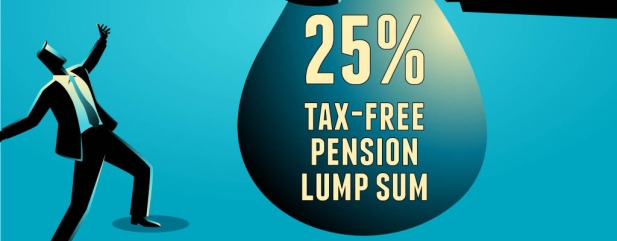Archived article
Please note that tax, investment, pension and ISA rules can change and the information and any views contained in this article may now be inaccurate.
What should I do with my 25% tax-free pension lump sum?

Figuring out what to do with your tax-free pension lump sum is a complex but extremely important decision.
If you’ve built up a sizeable pension pot, your lump sum could be worth more than £100,000 so it’s vital to ensure you use it wisely.
WHAT IS THE TAX-FREE CASH LUMP SUM?
You can start taking money from a workplace pension scheme or self-invested personal pension (SIPP) from age 55 under current rules.
Everyone is entitled to withdraw 25% of their pension tax-free, and the rest is taxed according to your income tax band.
You can choose to leave your tax-free cash lump sum invested, withdraw it all in one go or take it in smaller instalments.
Your tax-free amount doesn’t use up any of your personal allowance – the amount of income you don’t have to pay tax on.
SHOULD I TAKE THE MONEY OR KEEP IT INVESTED?
Unless you have a very specific requirement in mind, such as paying off a mortgage or other debts, leaving the tax-free cash sum untouched is a sensible move.
As long as the money is in your pension, it will continue to benefit from tax-free investment growth.
A lot of people withdraw their lump sum and stick it in a bank account or Cash ISA, but this could severely limit investment growth.
‘Withdrawing cash from a pension plan will clearly have an impact on the income you may get later on, and it is wise to think carefully before going ahead,’ says Fiona Tait, technical director at Intelligent Pensions.
There are some legitimate reasons why taking the cash sum could be a good idea – principally if you’re able to use the money to improve your finances by paying off debts.
This could be especially worthwhile if your borrowings are on a high APR rate of interest, although Tait suggests first considering whether you could reorganise your finances to reduce your interest costs.
‘I would also strongly caution against taking money from your pension if you have other sources of finance available to reduce your debt,’ adds Tait.
‘This is because the money which remains inside the pension will remain invested under favourable tax conditions, and it should also be available outside of your estate in the event of your death, allowing it to be passed on free of inheritance tax.’
WHY SHOULD I CONSIDER TAKING THE LUMP SUM IN INSTALMENTS?
It isn’t necessary to take your whole tax-free lump sum in one go, so it makes sense to only withdraw the amount you actually need.
Andrew Tully, pensions technical director at Retirement Advantage, points out that if your pension grows in value, you’ll end up getting more tax-free cash by taking it in instalments over time than if you took it in one go.
‘Another key reason to think about phasing your tax-free cash is that by taking benefits gradually, rather than all at once, you can delay the impact of any lifetime allowance tax charge,’ says Tully.
You can choose to take tax-free cash as and when it is needed to top up your income.
‘This is tax-efficient and may mean you avoid taking taxable income in years when you have high income from other sources, for example employment if you are thinking about going part-time and easing into retirement,’ Tully explains.
WHAT SHOULD I DO IF I’M A HIGHER-RATE TAXPAYER?
If you’re a higher-rate taxpayer, the ability to take 25% of your pension pot tax-free and without it adding to your income tax bill is very attractive.
It could even save you money in the long run if you expect to continue to be a higher-rate taxpayer in retirement. This is because the remaining 75% of pension withdrawals are taxed according to your income tax band.
Another perk is that taking the tax-free cash lump sum doesn’t affect your annual allowance – the amount you can save into a pension without incurring a tax charge.
The annual allowance reduces from £40,000 to £4,000 a year as soon as you access the remaining 75%, unless it’s a
small pension pot.
‘Just taking the tax-free cash and leaving the remainder of the pension fund untouched allows you to retain the higher annual allowance, giving you the flexibility to continue to pay significant pension contributions,’ says Kate Smith, head of pensions at Aegon.
‘This can be particularly tax-efficient for higher-rate taxpayers, as they are entitled to 40% tax relief on their pension contributions, or £2 for every £3 paid in.’
I’VE GOT A SMALL PENSION POT – WHAT DO I NEED TO THINK ABOUT?
There are special tax rules for small pension pots where each is worth no more than £10,000.
From age 55, you can cash in up to three small pots to a total of £30,000.
As with other pensions, 25% is tax-free, with the remainder added to your taxable income.
A major advantage is that using the small pension pots rule doesn’t affect your annual allowance or lifetime allowance.
‘Using the small pot rule allows you to retain the higher annual allowance, giving you the flexibility to continue to pay significant pension contributions,’ explains Smith.
HOW WILL THE TAX-FREE LUMP SUM AFFECT IHT?
Any money that stays in your pension remains outside your estate, meaning no inheritance tax (IHT) is due on it when you die.
According to figures from Mattioli Woods, someone with a pension worth £500,000 would increase the value of their estate by £125,000 if they took out their tax-free lump sum.
Assuming their home and personal investments are worth £300,000 each, their IHT bill would rise from £60,000 to an eye-watering £110,000.
Important information:
These articles are provided by Shares magazine which is published by AJ Bell Media, a part of AJ Bell. Shares is not written by AJ Bell.
Shares is provided for your general information and use and is not a personal recommendation to invest. It is not intended to be relied upon by you in making or not making any investment decisions. The investments referred to in these articles will not be suitable for all investors. If in doubt please seek appropriate independent financial advice.
Investors acting on the information in these articles do so at their own risk and AJ Bell Media and its staff do not accept liability for losses suffered by investors as a result of their investment decisions.

 magazine
magazine









